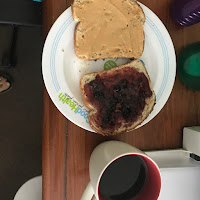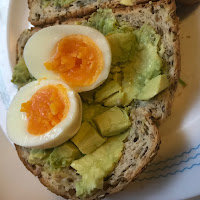Recently I made a commitment to try and improve
my baking skills. As that bread is something I eat on most days, it seemed like
the most logical product to try and attempt making at home. Here is how it
went.
I am not a
baker. In fact, I have a very bad track record at trying to bake anything. I
can make simple oatmeal cookies or a banana loaf but that is as far as it goes.
Or used to go anyway. Because I decided to try make bread and make it good!
Normally my
biggest issue while cooking, baking or preparing food is the fact that I do not
seem to be able to stick to a recipe. For me recipe is more like a general
guideline that gives you an idea which ingredients should be included but
depending on the availability and taste preferences I tend to mix and match things
as I go along. With salads, stews or dishes that do not require too much
integration of the various components, this normally works well but baking is
something where recipes really come in handy. So this time I decided that I
will stick to the recipe, no matter what! That was a nice plan but my free
spirit took over eventually.
So the original
recipe that I was supposed to use was the following (I found it on Pinterest which
I find a really useful network for various blogs and advice):
-
3 cups of all-purpose flour (I used Organic but I am sure regular
variety would work just as well)
-
1 tsp of dry active yeast (I am sure that other variety would
work as well but the order of mixing the ingredients would probably be
different – I mixed my yeast with the other dry ingredients as outlined in the
instructions below)
-
1.5 tsp of table salt
-
1.5 cups of lukewarm water (my tap is not too hot so I just
used the water from hot water tap – do not use boiling water or water that is
too hot because it will kill the yeast and the dough won’t raise)
1. The recipe suggested that all of the
dry ingredients should be mixed well together in a bowl. Water should be added
last so that if you need a little bit extra (I ended up using a total of 2
cups) to make the dough sticky then you can add it depending on the need. The
dough is supposed to look sticky (although not really liquid) and not dry. It
will get bubbly on surface once the yeast starts activating.
2. Once you have mixed everything well together
(I used a wooden spoon), you are supposed to cover the bowl with saran wrap (or
cling film as they call it outside North America) and leave it for 12-16 hours
for the yeast to ‘raise’ the dough. It should double in size. Make sure to use
a bowl that the wrap actually ‘clings’ to because the idea is that you are
creating a vacuum environment.
3. Once you are ready to make the
bread, turn the oven on at 400 degrees and place your baking dish inside for
pre-heating – leave 20-30 minutes for the oven to get hot. While this is
happening, create a surface covered with flour and flip your dough on it (cover
your hands with flour before touching the dough). Form a ‘ball’ and let it sit
on the surface until the oven is ready to be used. The dough should further
raise a little more.
4. Once ready to go in, flip the dough
into a baking dish and make a cross or a couple of stripes on it. Ideally it
should then be covered with a solid lid but I did not have one in handy so I
just covered it with aluminium foil (you will have to cover it with something
because otherwise the top will burn before the bread is ready). Place the dish
in the oven and bake for 30 minutes.
5. After 30 minutes has passed, remove
the cover and bake for an additional 15-30 minutes – this will let the bread
get nice and golden brown (mine took 20 minutes further).
6. Once the bread is ready, leave it to
cool for an hour or so. If you need to cut it earlier, try to cut it with a
sharp knife because otherwise you might break it.
So there
were a couple of things that I was not quite sure about when following the
procedure so I googled for some advice from more experienced bakers.
My first
issue was the fact that the dry yeast came in little sealed sachets and although
I could tell that one sachet was by far more that a teaspoon, I decided to pour
the whole thing in. After having done so, I consulted with some websites that using
too much yeast is not considered good because although it will make the dough ‘raise’
faster, for it to form a nice fluffy texture slow raising is highly preferential.
Also, some people apparently find the smell of yeast very unpleasant so there
were some comments about ‘over-yeasting’ and the smell of it. I do not really understand
it because in bakeries I have always almost liked the mild smell of yeast but
maybe I am a bit weird.
I do have
to admit that adding all that yeast made my dough raise really fast. Of course,
I did not know this was going to happen so I was actually more concerned about
the opposite possibility. I remember when one of my friends in Canada was
trying to make bread and her house was very cold so she had some issues getting
the dough raise. She was joking about ‘cuddling’ the dough and having the bowl
in the middle of the bed while sleeping because it seemed to be the warmest
place. Although my house is quite warm (and it is summer in Melbourne!), I
decided that the sunniest place indeed is my bed next to a big window. I was
thinking of just keeping an eye on it for a while and potentially moving it for
the night but little did I know that my dough was ready to be baked well before
that. Let’s say, due to all the yeast I added, I could have probably left it in
a cold cellar because – my bowl was full of dough in less than an hour from the
time I put it aside! Although I read some comments on the internet that should
this happen, it would be better to half the dough and put half of it into a
freezer for next time and then use the other half by mixing it with more flour
and waiting for it to raise again. It sounded pretty messy and the odds of
something going wrong with it seemed bigger so I decided to take my chances and
make the bread with the super-fast bread dough that I had already created.
When I
flipped the dough over on a big plate covered with flour, it kind of collapsed
a little because there was a lot of air in the dough. So first of all the dough
‘ball’ looked quite small but after I had left it for a while, it started
raising again and took a promising shape. I read some comments about other
people’s experiences of how dough that had too much yeast in it had collapsed
in the oven. Beginner’s luck or something else – luckily nothing of that kind
happened to my bread. I do have to admit that the texture was a tiny bit
thicker and tenser than of that of an ideal fluffy loaf but in general the end
result was a nice filling sandwich bread that looked and tasted really good.
All in all,
I am really proud of myself for trying to bake bread. Next time I will try to
avoid the mistakes I encountered at my first attempt. I am also thinking of
trying the same recipe with whole wheat flour to create a healthier variety.
Adding some seeds might be interesting as well. It is amazing how easy making
bread at home is and it is really cheap as well.
Happy baking!






































